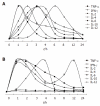Immune mechanisms of Concanavalin A model of autoimmune hepatitis
- PMID: 22253517
- PMCID: PMC3257438
- DOI: 10.3748/wjg.v18.i2.119
Immune mechanisms of Concanavalin A model of autoimmune hepatitis
Abstract
As a chronic inflammatory disease of the liver, the pathogenic mechanisms of autoimmune hepatitis (AIH) have not yet been elucidated, with prognosis and diagnosis remaining unsatisfied. Currently the only viable treatments of AIH are immunosuppressant application and liver transplantation. It is considered that lack of good animal AIH models is the main reason for the shortage of a simple and efficient cure. The Concanavalin A (Con A) model is a typical and well established model for investigating T-cell and macrophage dependent liver injury in mice, which closely mimics the pathogenesis mechanisms and pathological changes of patients, and is regarded as the best experimental model for AIH research so far. In this paper we elucidated the pathogenic mechanisms of AIH and the evolution of relative animal models. We go on to further focus on Con A-induced liver injury from the point of immunological mechanisms and the change of cytokine levels. Finally, we manifested the clinical significance of the AIH animal models and the challenges they would meet during their future development.
Keywords: Animal models; Autoimmune hepatitis; Concanavalin A.
Figures


References
-
- Manns MP, Vogel A. Autoimmune hepatitis, from mechanisms to therapy. Hepatology. 2006;43:S132–S144. - PubMed
-
- Primo J, Maroto N, Martínez M, Antón MD, Zaragoza A, Giner R, Devesa F, Merino C, del Olmo JA. Incidence of adult form of autoimmune hepatitis in Valencia (Spain) Acta Gastroenterol Belg. 2009;72:402–406. - PubMed
-
- Clark JM, Brancati FL, Diehl AM. The prevalence and etiology of elevated aminotransferase levels in the United States. Am J Gastroenterol. 2003;98:960–967. - PubMed
-
- Czaja AJ, Carpenter HA. Distinctive clinical phenotype and treatment outcome of type 1 autoimmune hepatitis in the elderly. Hepatology. 2006;43:532–538. - PubMed
-
- Al-Chalabi T, Underhill JA, Portmann BC, McFarlane IG, Heneghan MA. Impact of gender on the long-term outcome and survival of patients with autoimmune hepatitis. J Hepatol. 2008;48:140–147. - PubMed
Publication types
MeSH terms
Substances
LinkOut - more resources
Full Text Sources
Other Literature Sources
Research Materials

